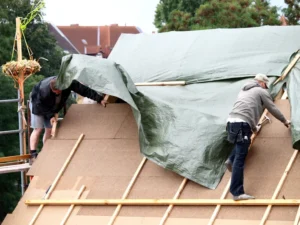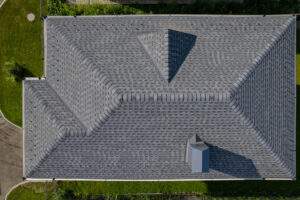While the lifespan of a roof can vary widely, it’s not solely determined by the material. While asphalt shingles typically last 15-20 years, metal or architectural shingles can endure for 40-70 years, and tile or slate may even outlast your home.
But these are just general estimates. To truly understand how long your roof will last in Fargo and Minnesota, you must consider three crucial factors. Keep reading to find out more about these factors.
Key Takeaways
- Your roof’s life depends on materials, weather, and how well it was installed.
- Regular inspections, trimming branches, and cleaning gutters keep your roof in good shape.
- Get a professional inspection to see how long your roof will last.
3 Factors That Affect How Long A Roof Lasts
The lifespan of your roof depends on a few basic things. It’s all about what materials you pick, the local climate, and how good the installation is. Let’s break it down.
1. What Materials You Pick
Roofing materials can vary widely in their lifespan and durability. Here’s a closer look at common options:
Asphalt Shingles
As one of the most commonly used roofing materials, asphalt shingles are popular due to their affordability and ease of installation. Standard asphalt shingles last 15 to 20 years, but higher-quality architectural shingles can last up to 30 years.
Despite their lower lifespan than other materials, they’re often the go-to for budget-conscious homeowners.
Metal Roofs
Metal roofing, including aluminum, steel, and copper, is highly durable and weather-resistant. These roofs can handle extreme conditions, from heavy snowfall to intense heat. They are often rated to last between 40 to 70 years. Copper roofs, in particular, may exceed 70 years but can come at a higher cost.
Clay Tiles
Popular in warmer climates, clay tiles are known for their durability and natural heat resistance. These tiles can withstand harsh environmental conditions such as heavy rain and strong winds. If properly maintained, a clay tile roof can last 50 to 100 years, making it a solid long-term investment.
Slate Roofs
Slate roofs are some of the longest-lasting options, known for their natural stone material and premium durability. A well-maintained slate roof can last anywhere from 75 to 200 years. But, the material is heavier and requires reinforced structural support, which adds to installation costs.
Wood Roofs
Typically made from cedar, redwood, or pine, wood roofs offer an eco-friendly and aesthetically pleasing option. They generally last 25 to 30 years if properly maintained. Their lifespan may decrease by 5-10 years in areas prone to moisture.
2. Where You Are in Fargo and Minnesota
The longevity of your roof largely depends on the climate and environmental factors where you live. Different weather conditions in Fargo and Minnesota can speed up wear and tear on roofing materials.
Hail
Hailstorms cause significant damage, especially to asphalt shingles, which can crack or lose granules under impact. Metal roofs may dent, but they generally withstand hail better than other materials. Homes in hail-prone areas should schedule roof inspections after storms or at least once a year to check for cracked or missing shingles, granule loss, or dents.
Extreme Heat
In hotter climates, UV rays, particularly asphalt shingles, break down roofing materials faster. The intense heat can cause shingles to crack, curl, or warp over time. Metal roofs, clay tiles, and slate perform better under prolonged exposure to heat, as they are naturally more resistant to heat damage.
Cold Climates
Cold weather and frequent freeze-thaw cycles can damage a roof, particularly if the materials expand and contract. Ice dams are a significant concern in snowy regions, as ice buildup along the roof’s edges can cause leaks or structural damage if water gets trapped.
High Humidity
In humid climates, moisture encourages the growth of moss, algae, and mold, which can compromise the integrity of roofing materials. Over time, this can lead to water damage or rot, particularly on wood roofs. Algae-resistant shingles or regular cleaning can help mitigate these issues.
3. How Good the Installation Is
Roof installation is a critical factor in how long your roof lasts. Even the best materials you can find in Fargo and Minnesota can only succeed if installed correctly.
Proper Alignment of Shingles
Shingles must be aligned and installed with precision. Misaligned shingles can expose parts of the roof to wind and water, increasing the risk of leaks or shingles blowing off during storms.
Proper nailing is also essential—if nails are improperly placed or insufficient in number, shingles may come loose over time.
Ventilation
Proper roof ventilation is another key element in roof installation. Without proper airflow, heat and moisture can accumulate in the attic, leading to problems such as mold growth, insulation damage, and premature shingle aging. Well-ventilated roofs last longer in all weather conditions.
Flashing
Flashing seals joints and areas where the roof meets other structures, such as chimneys or skylights. Poor flashing installation can lead to roof leaks and water damage. Using high-quality flashing materials and ensuring they are installed securely can prevent significant issues down the road.
Fastening
The type of fasteners used and how they are applied affect the roof’s ability to stay intact during high winds and storms. Contractors must follow manufacturer guidelines for fasteners to ensure durability.
How to Extend the Life of Your Roof
Taking care of your roof is key to making it last longer. Here’s how you can keep things in check and avoid major problems down the road.
Schedule Preventative Roof Care
Inspecting your roof once a year can save you from costly roof repairs. Get a professional to check for these common issues:
- Loose or Missing Shingles: Inspect for cracked, curled, or missing shingles at least once a year or after major storms. Catching this early prevents water damage.
- Leaks or Water Damage: Conduct a thorough check twice yearly (spring and fall) or after severe weather events.
- Structural Integrity: Inspect your roof for any sagging annually, especially after heavy snow or rainfall periods. Address issues immediately to prevent collapse.
- Gutter Condition: Clean your gutters at least twice yearly (spring and fall) or more frequently if trees surround your home.
- Flashing Around Roof Openings: Check seals around chimneys, vents, and skylights at least once a year and after any severe storms.
- Mold, Algae, or Rot: Inspect for dark stains or growths twice yearly (spring and fall). Address any signs of mold or algae early to avoid weakening your roof.
- Roof Valleys: Check roof valleys for debris and water flow blockages twice a year, especially before and after the rainy season.
- Post-Severe Weather Check: After storms, immediately inspect for hail dents, wind damage, or cracks. Fix small problems before they get bigger.
Manage Overhanging Branches
Don’t ignore those branches hanging over your roof.
In storms, they can break off and cause major damage. Regular trimming can prevent that. Plus, fewer branches mean less debris like leaves and needles piling up and causing moisture problems.
Just remember, hire a roofing contractor with credentials if the branches are high up or large. They’ll finish the job right, and your roof will stay in great shape.
Keep Gutters Clean and Clear
Clogged gutters are your roof’s enemy. When water doesn’t drain right, you end up with mold, rot, and even structural damage.
Here’s how to keep your gutters clean:
- Clean twice a year – Do it in spring and fall to stay ahead of debris buildup.
- Use a sturdy ladder – Safety first.
- Remove debris by hand – Get rid of leaves, twigs, and other junk.
- Flush with a hose – Rinse out the smaller stuff to ensure proper water flow.
- Install gutter guards – These can reduce how often you need to clean.
- Check for leaks or damage – Fix any problems to keep water flowing away from your roof.
Book an Inspection to Know Your Roof’s True Condition
Worried about how long your roof will last in Fargo and Minnesota? Let Allstar Construction give you the facts. Contact us for a detailed roof inspection and advice on extending its life.
We’ll check for damage, offer expert tips, and help you maintain your roof for the long haul. Contact us today at 701-380-5931 for a free consultation and get the real story on your roof’s durability.






